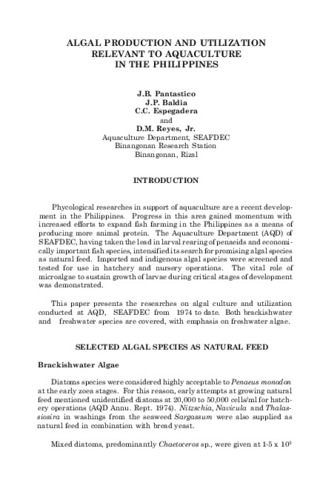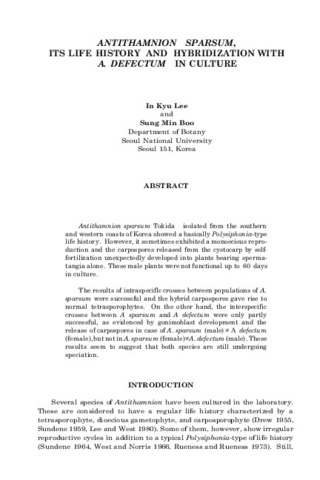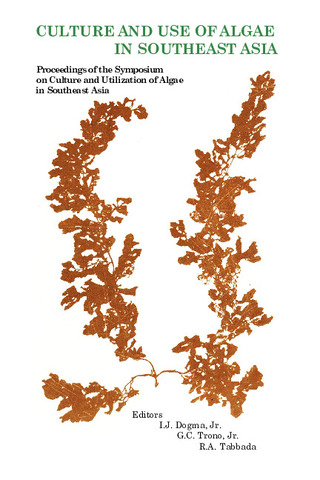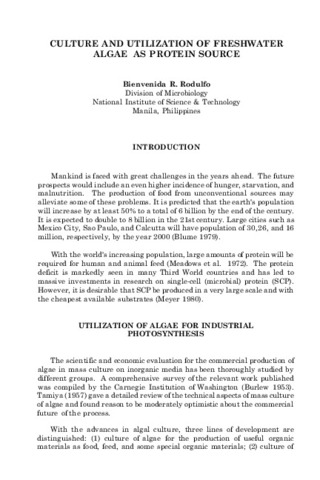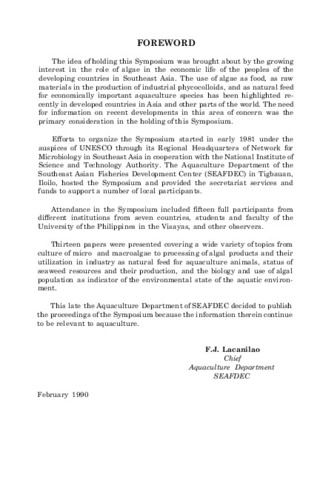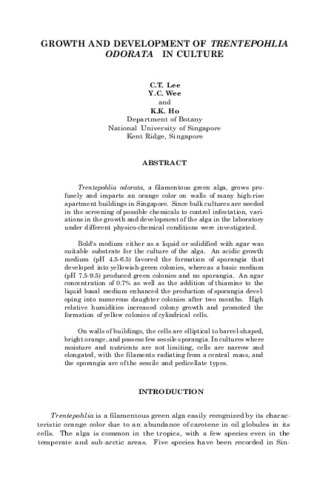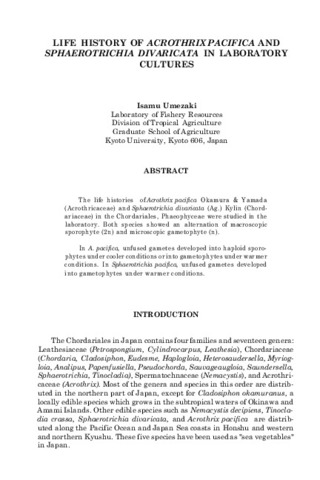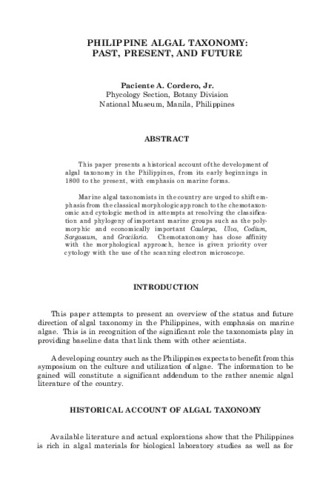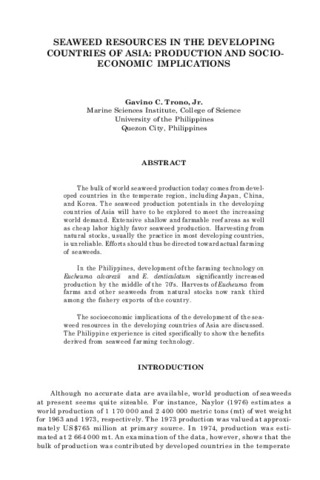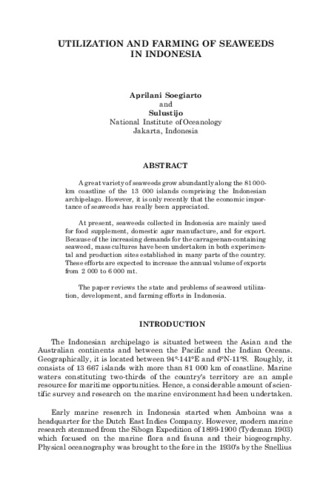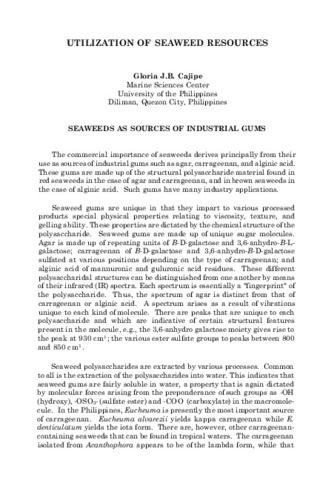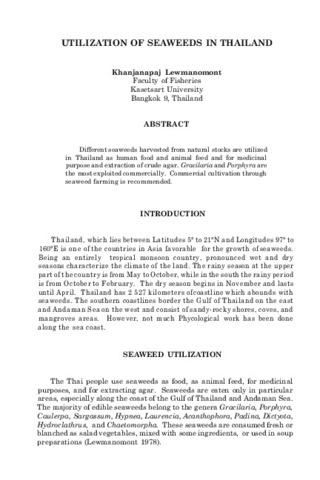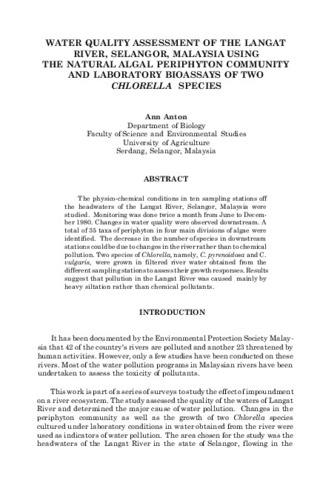Browsing Culture and use of algae in Southeast Asia by Title
Now showing items 1-15 of 15
-
Agroindustrial waste products as sources of cheap substrates for algal single-cell protein production
(Aquaculture Department, Southeast Asian Fisheries Development Center, 1990)Four types of agroindustrial waste products were tested for their suitability as substrates for Chlorella single-cell protein production. Based on cell density on day 7, unsterilized rice straw filtrate, Tris-buffered ... -
Algal production and utilization relevant to aquaculture in the Philippines
(Aquaculture Department, Southeast Asian Fisheries Development Center, 1990)An outline is given of research conducted at the Aquaculture Department of SEAFDEC at Rizal, Philippines regarding algal culture and utilization. Culture methods for both brackishwater and freshwater algae are described ... -
Antithamnion sparsum , its life history and hybridization with A. defectum in culture
(Aquaculture Department, Southeast Asian Fisheries Development Center, 1990)Antithamnion sparsum isolated from the southern and western coasts of Korea showed a basically Polysiphonia -type life history. However, it sometimes exhibited a monoecious reproduction and the carpospores released from ... -
Culture and use of algae in Southeast Asia. Proceedings of the Symposium on Culture and Utilization of Algae in Southeast Asia, 8-11 December 1981, Tigbauan, Iloilo, Philippines
(Aquaculture Department, Southeast Asian Fisheries Development Center, 1990)Abstracts of the 13 papers presented at the symposium are cited individually. A variety of topics were covered, including the culture of micro and macroalgae, the processing of algal products and their utilization in ... -
Culture and utilization of freshwater algae as protein source
(Aquaculture Department, Southeast Asian Fisheries Development Center, 1990)A discussion is presented on the commercial production of algae in mass culture conditions as a source of single-cell protein. Particular reference is made to the food situation in the Philippines, and research conducted ... -
Foreword
(Aquaculture Department, Southeast Asian Fisheries Development Center, 1990) -
Growth and development of Trentepohlia odorata in culture
(Aquaculture Department, Southeast Asian Fisheries Development Center, 1990)Trentepohlia odorata, a filamentous green alga, grows profusely and imparts an orange color on walls of many high-rise apartment buildings in Singapore. Since bulk cultures are needed in the screening of possible chemicals ... -
Life history of Acrothrix pacifica and Sphaerotrichia divaricata in laboratory cultures
(Aquaculture Department, Southeast Asian Fisheries Development Center, 1990)The life histories of Acrothrix pacifica and Sphaerotrichia divaricata in the Chordariales, Phaeophyceae were studied in the laboratory. Both species showed an alternation of macroscopic sporophyte (2n) and microscopic ... -
Philippine algal taxonomy: Past, present, and future
(Aquaculture Department, Southeast Asian Fisheries Development Center, 1990)This paper presents a historical account of the development of algal taxonomy in the Philippines, from its early beginnings in 1800 to the present, with emphasis on marine forms. Marine algal taxonomists in the country ... -
Present status of seaweed culture in Korea
(Aquaculture Department, Southeast Asian Fisheries Development Center, 1990)Seaweeds from natural stocks as well as from aquaculture have been widely utilized in Korea for a long time. Porphyra was first cultivated 360 years ago. The culture of Undaria pinnatifida was introduced more than 10 years ... -
Seaweed resources in the developing countries of Asia: Production and socio-economic implications
(Aquaculture Department, Southeast Asian Fisheries Development Center, 1990)The bulk of world seaweed production today comes from developed countries in the temperate region, including Japan, China, and Korea. The seaweed production potentials in the developing countries of Asia will have to be ... -
Utilization and farming of seaweeds in Indonesia
(Aquaculture Department, Southeast Asian Fisheries Development Center, 1990)A great variety of seaweeds grow abundantly along the 81,000-km coastline of the 13,000 islands comprising the Indonesian archipelago. However, it is only recently that the economic importance of seaweeds has really been ... -
Utilization of seaweed resources
(Aquaculture Department, Southeast Asian Fisheries Development Center, 1990)A brief discussion is presented on the commercial importance of seaweeds in the Philippines, which is mainly concerned with their use as sources of industrial gums such as agar, carrageenan, and alginic acid. Carrageenan ... -
Utilization of seaweeds in Thailand
(Aquaculture Department, Southeast Asian Fisheries Development Center, 1990)Different seaweeds harvested from natural stocks are utilized in Thailand as human food and animal feed and for medicinal purpose and extraction of crude agar. Gracilaria and Porphyra are the most exploited commercially. ... -
Water quality assessment of the Langat River, Selangor, Malaysia using the natural algal periphyton community and laboratory bioassays of two Chlorella species
(Aquaculture Department, Southeast Asian Fisheries Development Center, 1990)The physico-chemical conditions in 10 sampling stations off the headwaters of the Langat River, Selangor, Malaysia were studied. Monitoring was done twice a month from June to December 1980. Changes in water quality were ...


